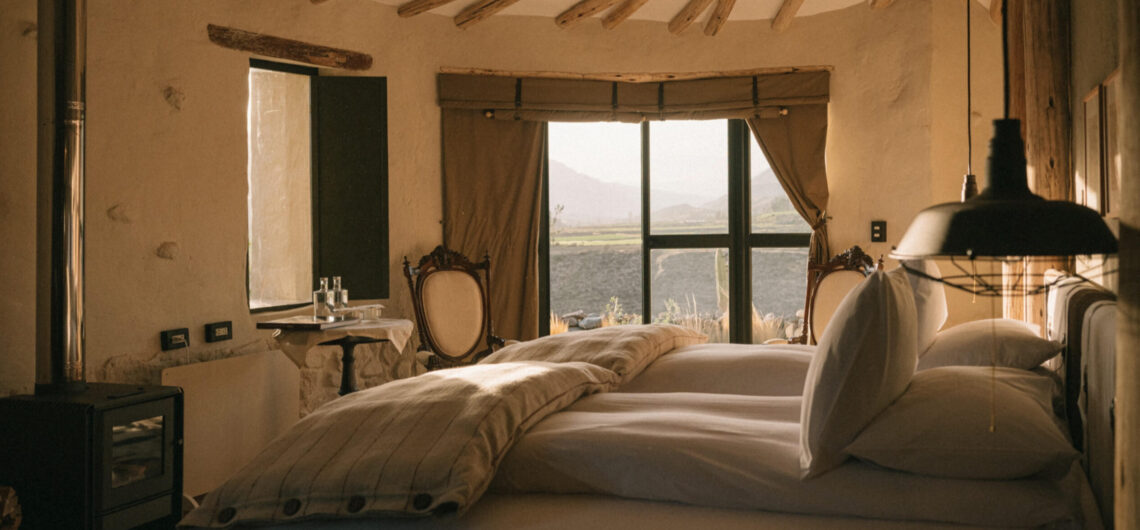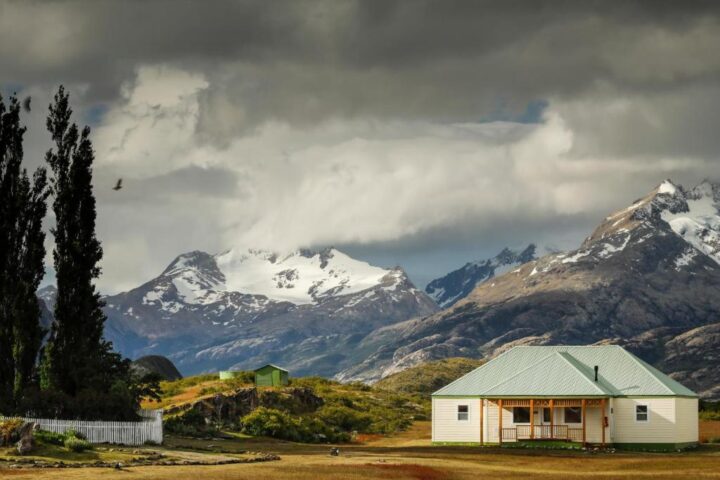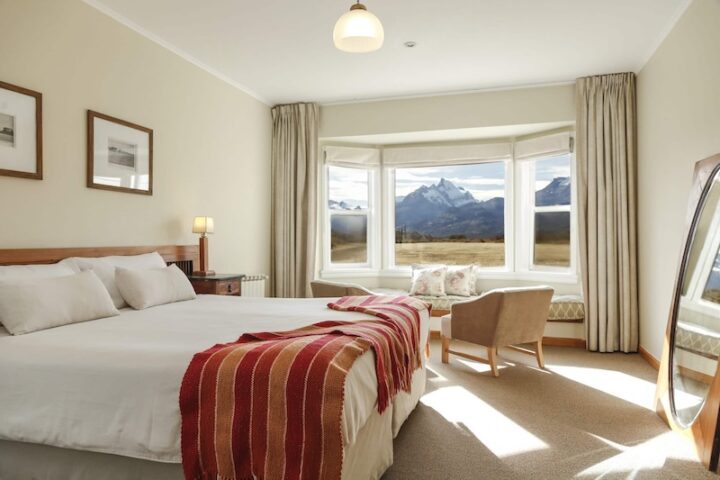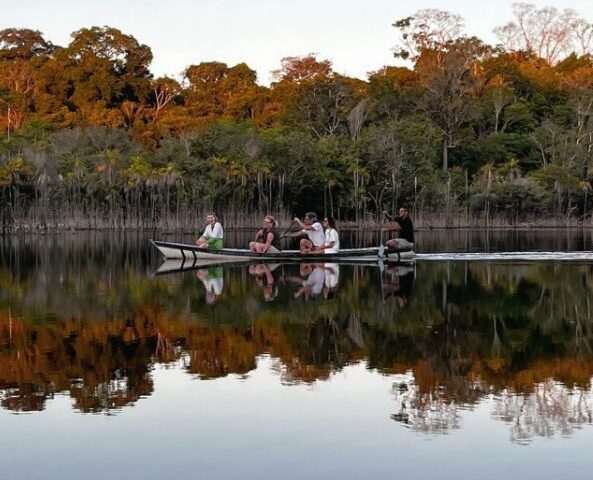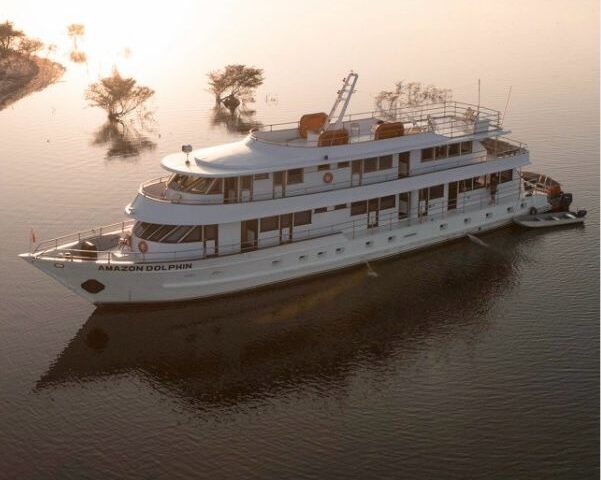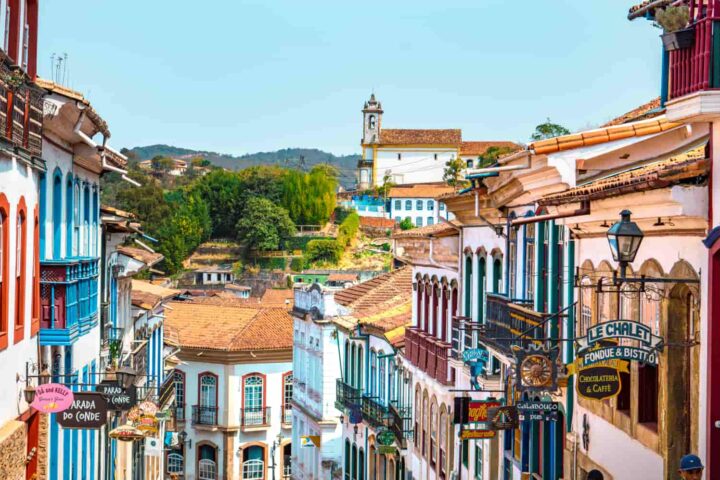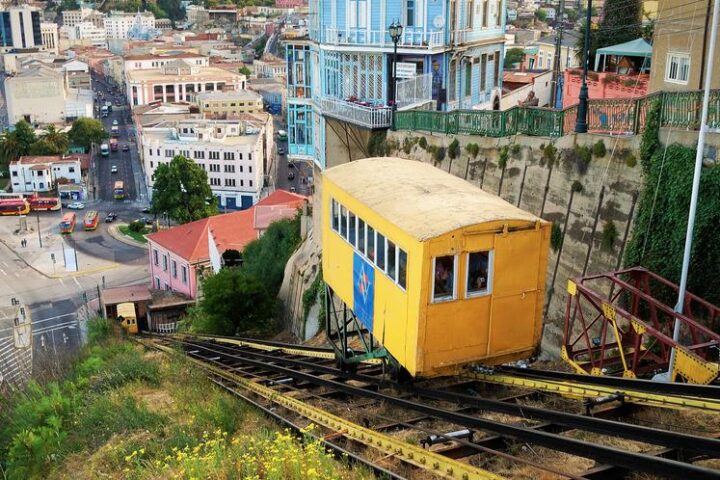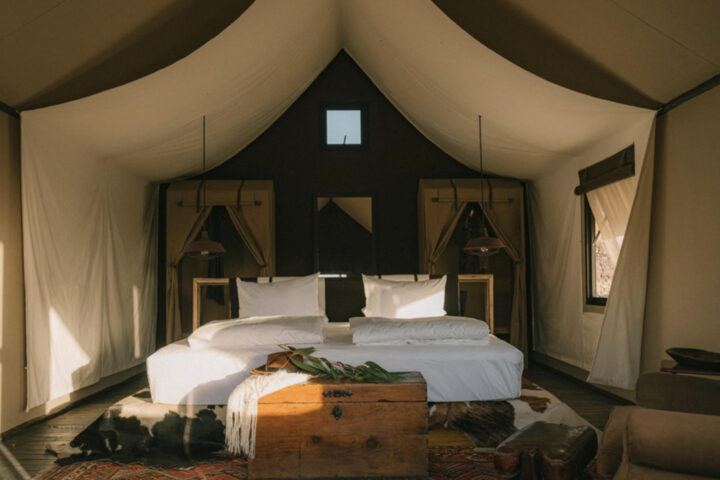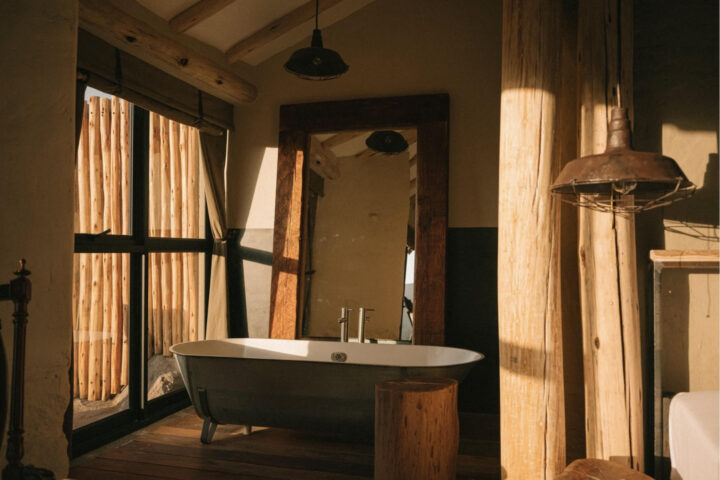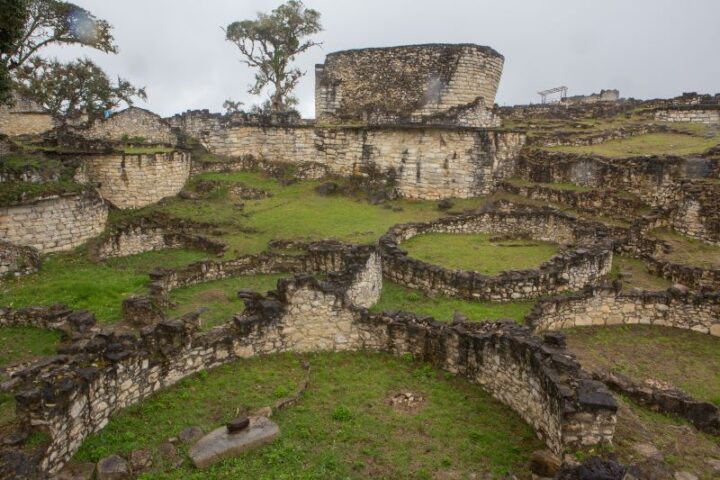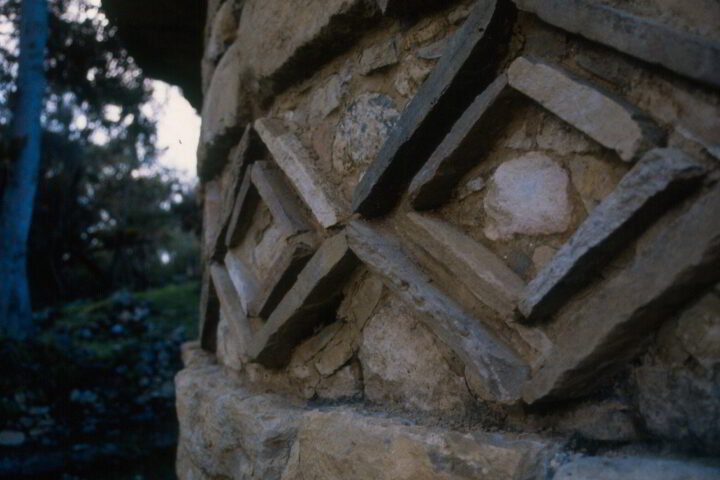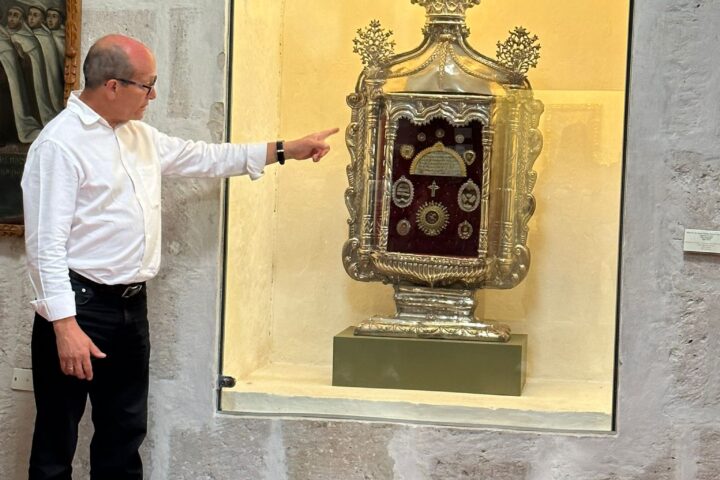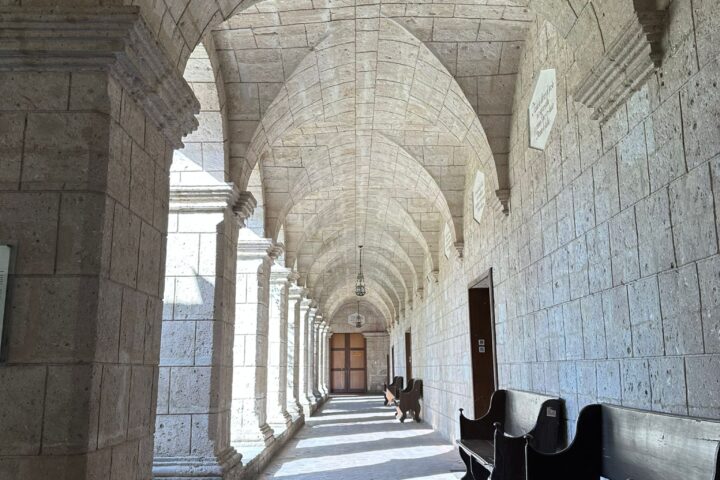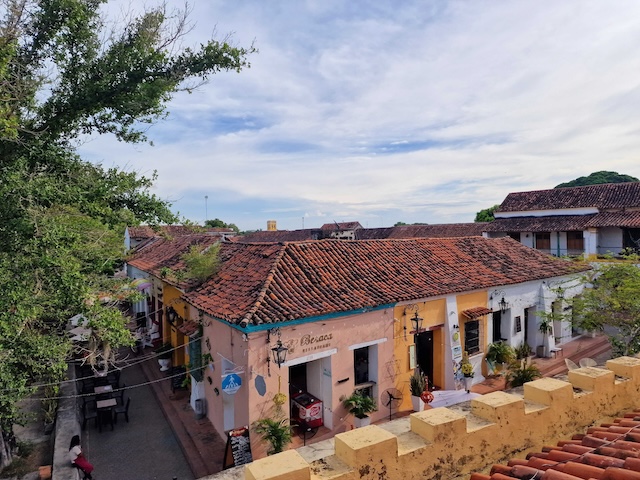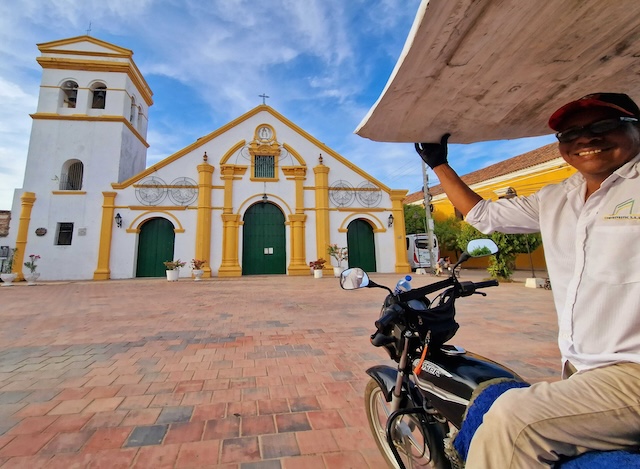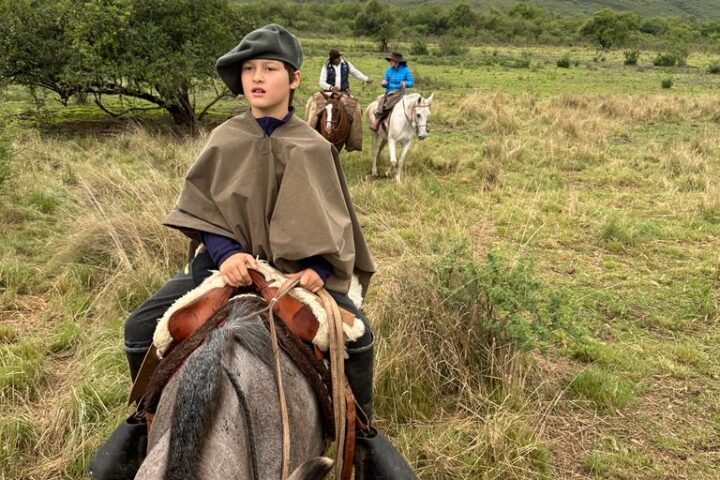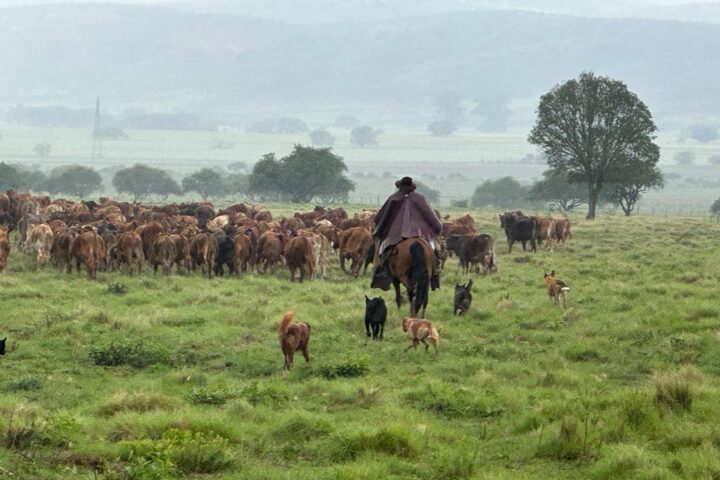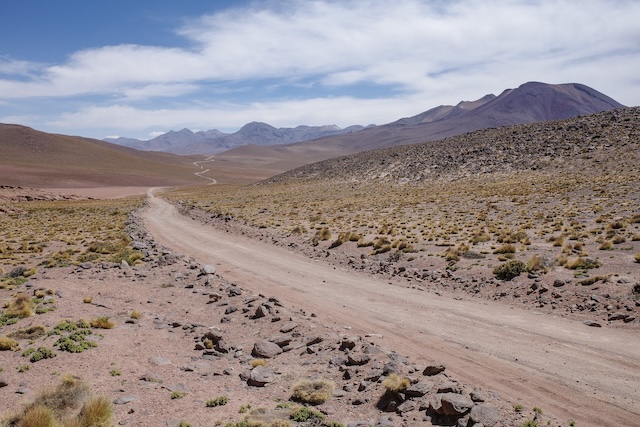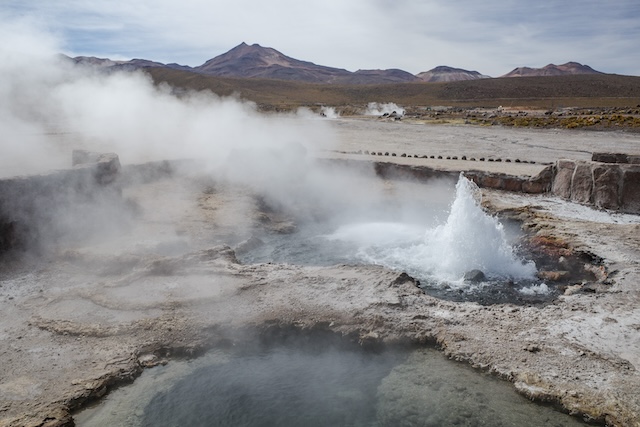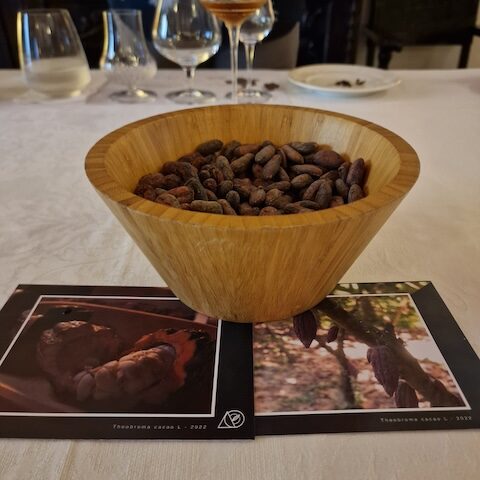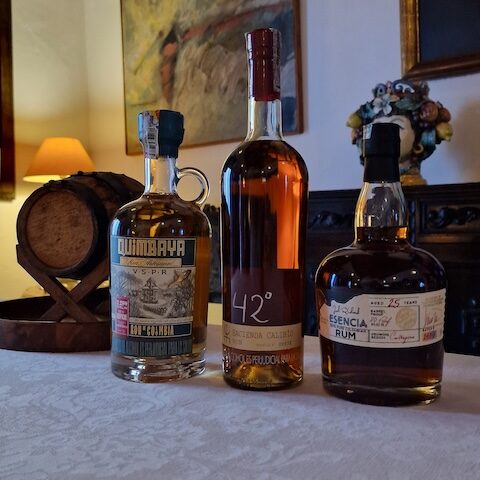As ever, our travel specialists have scoured the continent in search of ten of the best places in South America to visit in the year ahead. Our team zigzags across our region in search of entries robust enough to land a place on our yearly hotlist. Approving in person, whether these places adhere to stringent values of sustainability, authenticity, and purposeful travel to South America.
So, what does it take to catch our eye in 2024? Our top ten places to visit in South America aren’t those that shout the loudest. They often aren’t there to outdo the competition or pull in the most tourists, they are often on the periphery – in remote, rarely visited pockets of our continent; quietly, diligently, achieving true wonder.
10 of the Best Places to Visit in South America: Our 2024 Hotlist
Beginning with an incredibly remote lodging in Patagonia, one only reachable via boat crossing on the northern tip of Lago Argentino to a vibrant Chilean port often forgotten by tourist maps, where neighborhoods are connected by a labyrinth of ladders, to some of the most precious and rarely-visited regions of Peru this is your exclusive guide to ten best places in South America.
1. Estancia Cristina: The heart of untamed Patagonia
There is only one way to reach the remote lodgings of Estancia Cristina. To get here you must sail across the north side of Lago Argentino – found within the bounds of the national park established to protect the Campo de Hielo Patagonico Sur. It is a majestic valley surrounded by natural wonders and steeped in the history of explorers who have come before.
As you’d expect from our guide to ten of the best places in South America in 2024, Estancia Cristina is a property in its own league – it is the only lodging found on Lago Argentino’s shoreline. Tucked away amongst celestial lakes, snow-capped peaks, and the second-largest glacier in the Parque Nacional Los Glaciares, the natural beauty here is astounding.
But what sets Estancia Cristina apart even further is the story. Originally worked as a ranch for sheep wool production by the Masters family from 1900 – the place passed through the generations until Janet Masters, wife of one of the sons – decided to adapt the Estancia for tourism. Today Estancia Cristina is a haven amongst the wild bucolic land, welcoming visitors from all over the world to, as they put it, stay where the wild souls stay. Our very own Marisol – founder of Aracari – will stay here herself when she travels to Patagonia in March of this year. More on that later.
The expeditions at Estancia Cristina offer adventures into an ancient territory. Opt to hike through the silence, contemplating the remains of the ages, and discovering the tracks and traces left behind by the prehistoric glaciers. Ride on horseback through the remote country and mountain ranges, meandering through the pristine and expansive glacial landscape of Rio Caterina. Or, even cast your lines in search of the prized chinook salmon.
There are just 20 rooms, distributed across five Casas, each one with the same design and elegant comfort, and all of them surrounding the main lodge. Our recommendation is three nights here, permitting you enough time to soak up the majestic beauty of the places, whilst also leaving vacation days to see more of this enormous landscape.
It’ll be no surprise that a trip here requires expert planning – perhaps more so than any other of our top 10 places to visit in South America in 2024. Thankfully Aracari Travel Designers are well-equipped to curate a unique adventure centered around a stay at Estancia Cristina, book a call today to find out more.
2. Kaiara: Set sail through the remote Brazilian Amazon
Launched in November 2022, Kaiara is the brainchild of Brazilian-born Martin Frankenberg, who has previously spent many years in the luxury travel industry and is a friend of Aracari. Martin’s idea to launch sustainable voyages into the remote Brazilian Amazon was first sparked after seeing wildfires smoke over the city of São Paulo in 2018, which gave him the push to become more involved in Amazon conservation and social welfare.
Kaiara earns its spot in 10 of the best places in South America not as a destination exactly but rather as a means of experiencing an exceptionally remote pocket of our continent. Founded on a strong philanthropic ethos, the team here works with riverside communities to offer guests experiences that span from cultural to botanical to gastronomical. Aboard one of three vessels, guests can listen to the call of the Amazon sounds sprung from the greatest biodiversity on the planet and discover its greatest wealth: the people of the forest. Gliding through the waters, the vessels enter the immense forest, anchoring at remote, pristine beaches that emerge from the rivers – many of which are home to rural, indigenous communities.
There are three with whom Kaiara expeditions work directly. Coroca; a community of 150 people on the edge of the Arapiuns River which is in front of the famous caracaraí and ponta grande beach. Atodi village; located on the banks of the Arapiuns River, on a stunning point of sand, the village is made up of 60 families. Several activities promote the community’s livelihood, such as the harvest of buriti to sell in the city of Alter do Chão. And finally; Jamaraquá, one of the most interesting communities in the Tapajós National Forest (flona) of tapajós, located approximately 2.5 hours by boat from alter do chão, up the Tapajós River. The community found here has a diverse craft store focusing on bio-jewelry, made mainly with latex and seeds.
Navigating through fresh and abundant waters, it is possible in a single trip, to visit three ecosystems of the great Amazon rivers during a Kaiara expedition: the green waters of the Tapajós, the white waters of the Amazon, and the black waters of the Arapiuns. And aboard its spacious and comfortable boats, you can expect fantastic authentic Amazonian food and exceptional hospitality.
Best experienced as part of one of our luxury Brazil itineraries such as Finding Paradise: The Treasures of Brazil – let us connect you to a landscape that is still relentlessly and exhilaratingly green in 2024.
3. The Chilean port city of Valparaiso: Street art and funicular rides
The next entry in our list of ten of the best places to visit in South America is the choice of Mark Green, one of our Travel Designers who has recently visited. Found around two hours from the Chilean capital of Santiago lies the city of Valparaíso, or Valpo – as it is affectionally known by locals. Brimming vibrancy and character, Valparaíso is a city arranged like an amphitheater – its steep hillsides dotted with brightly colored colonial buildings that slope down towards its historic port.
A warren of alleys propped precariously on the valley connects Valparaiso’s many neighborhoods with vertical stairwells transforming it into a labyrinth of ladders. Around half of the city’s original 31 elevators, built in the late 1800s to ease the strain of navigating near-vertical hills, still trundle up and down the slopes.
It was once the first and most important merchant port on the sea routes that linked the Atlantic and Pacific oceans, and the promise of prosperity and opportunity were the building blocks of Valpo’s identity. It was a port of call for commercial ships crossing via the Strait of Magellan and attracted thousands of immigrants in the late 1800s until the construction of the Panama Canal sent traders a more convenient route. After that, development slowed, allowing its harbor and distinctive urban fabric to survive as an exceptional testimony to early globalization.
Because of its history, Valparaíso has been populated and influenced by people from all over the world. Abandoned mansions and brightly colored houses still cover the 45 hills. Towards the port, palm trees gifted from Brazil, an archway built by the British and what was Latin America’s first stock exchange all stand as vestiges of a time when money flowed as easily as the spray paint does today.
Although defined by its past, this unconventional city today thrives as a bohemian hub of creativity, one of the reasons why we have listed it among ten places to visit in South America for 2024. More than 400 graffiti artists have turned Valparaiso into one of the world’s largest unofficial open-air museums of street art, where the authorities now accept graffiti as part of the city’s culture and appeal.
But how do our trusted Chilean partners recommend spending time here? The hills of Cerro Concepcion and Cerro Alegre are recognized as UNESCO World Heritage sites and are a wonderful way to spend a morning with many promenades and great views of the bay below. Enjoy lunch and a local wine – indeed some of the country’s best vineyards surround the city – before opting for an afternoon visiting the home of influential Chilean Gonzalo Ilabaca and heading down to the port for a hands-on graffiti workshop.
4. PUQIO: A glorious, tented hamlet in the Colca Valley
From the same team behind Cirqa – an endlessly chic hotel in the heart of Arequipa which featured in our 2022 Travel Hotlist – comes PUQIO. A beautiful, tented hamlet deep in Colca Valley – home to the Colca Canyon – a dramatic gash in Peru’s Martian landscape boasting a depth that is twice that of the Grand Canyon. It takes around 3 hours from the chalky city of Arequipa to reach PUQIO – a journey that passes fuming volcanoes and sweeping grasslands as you slowly leave the bustle of the metropolis behind you.
PUQIO only opened in September of 2023, but true to our ethos of try before you sell – team Aracari has already spent two nights here during our annual offsite in December.
The lodgings are safari-style tents and adobe huts and all meals and drinks included, expect local dishes cooked in clay ovens, or over an open flame, complimented by the refreshing taste of pisco cocktails. Daily excursions have been expertly designed to absorb the secrets of Valle Colca, from high-altitude trekking to delving into ancient plant wisdom with a natural herbalist to soaking in the thermal baths of Uyo Uyo and visiting some of the best textile weavers in the Andes.
Once the sun sets and the stars shine in the unpolluted skies above, a soak in your outdoor bathtub is the perfect antidote to a long day’s exploring, before retiring around the fire. As PIQUO themselves put it like this; ‘Our tented hamlet is designed to harken back to childhood yearnings, reawakening an instinct to explore’. Well, we couldn’t agree more.
A stay at PUQIO is perhaps best combined with one of our southern Peru itineraries, especially one that is focused on the foodie delights of this region such as Travel with Taste: Peru’s Spellbinding South. From the colonial cliffs of Lima to the cobbled streets of Cusco, to the sweeping valleys of the Colca Canyon, this two-week private journey promises the ultimate Peruvian adventure.
5. Chachapoyas and the Citadel of Kuelap: Peru’s Best-Kept Secrets
The reopening of the Kuelap, deep in the heart of Chachapoyas, has put this remote region of Peru on the map recently. It’s not an obvious choice for the frenzy of media coverage it has received over the last few months, with both Conde Nast Traveler and Travel + Leisure citing it as a top place to visit in South America, but it is in doubt deserving of the accolades. Both of the aforementioned publications mention Aracari as the medium through which to experience this unspoiled pocket and here’s why.
At Aracari, connecting our clients to the wonders of Peru away from Machu Picchu and the Sacred Valley is no new thing. There is a certain kind of magic in discovering a country away from its most popular sites, and our private Peru tour Peru’s Best-Kept Secrets offers exactly that.
Its path crosses to the lesser-visited, remote region of Chachapoyas. Here you’ll spend six days immersed in the dense cloud forest, an area once ruled by the pre-Inca Chachapoya culture – also known as “The Cloud People”– who populated this area around the 10th century A.D. Led by our expert guides, you’ll uncover a fascinating history read in the ruins left behind by those who lived here including the pre-Inca fortified citadel of Kuelap.
Kuelap was forced to close due in 2022 to damage caused by heavy rainfall. Having just recently reopened, Aracari clients are afforded the chance to enjoy a full tour of the impressive pre-Columbian site. Built by the pre-Inca Chachapoya civilization, known as the ‘warriors of the clouds’, Kuelap is one of the biggest ancient stone complexes in the western hemisphere. It is estimated that up to 3,000 people lived here at its height. There are multiple levels within the complex and over 400 constructions, most of which are cylindrical, with some friezes and decorative patterns remaining.
Sounds fascinating, right? Take our hand as we take you on a private tour into Peru’s Best Kept Secrets.
6. Santa Teresa Monastery: Uncover history with the leading scholar and museum director.
For us, this next experience is one of the most exciting among our ten of the best places in South America, and here’s why. Recently enjoyed by team Aracari during our annual offsite to Arequipa, this particular visit to the Santa Teresa Monastery is unlike any usual tour. That’s because your guide for the next few hours is the revered director of Santa Teresa, Franz Grupp – a privilege afforded to Aracari guests.
Franz is one of Aracari’s specialist guides, a veritable cultural expert, art historian, and curator, who gives unparalleled insight into this historic site. Franz has been involved in important restoration projects throughout Peru and was part of the team that presented the historical center of Arequipa to UNESCO to be regarded as a designated Cultural Heritage City, a status it achieved in 2000.
Constructed in 1710, Santa Teresa Monastery is a smaller, lesser-known monastery compared to Santa Catalina, also in Arequipa. Santa Teresa hasn’t been open as long as the latter either; almost 300 years after its foundation, it first opened its treasures to the public in 2005.
Santa Teresa’s appeal is that it functions as a comprehensive Museum of Viceregal Art, as well as a living museum: 15 cloistered Carmelite nuns still live here. These nuns remain inside the convent and do not interact with the outside world – they cannot be seen by visitors, nor see them.
The monastery itself is divided into thirteen gallery rooms displaying hundreds of works of art and the rooms are themed, whether by retaining their original style or displaying a certain kind of art or artistry. The collections include sculptures, murals, precious metalworks, and religious art from the 16th, 17th, and 18th centuries. Some of the more conventional silver and gold pieces are still used regularly in the monastery’s daily activities.
Alongside the pieces housed in Santa Teresa – this experience crosses to the Andean Sanctuary Museum too. It’s here that you’ll find the incredibly well-preserved ‘Juanita’ mummy. Discovered atop Ampato Mountain in 1995, in the Andes of Southern Peru, Juanita is not a mummy but a frozen 12-year-old Inca girl who was sacrificed to the gods in the 1450s. It would have been a true privilege of the parents for their child to be selected as a sacrifice. Juanita – like other human sacrifices – would have been led up the cold mountain with priests before being sacrificed, carrying with them the likes of coca leaves, food, and offerings that formed part of this ritual. Juniata was thrust back into the public eye in October of last year as archaeologists revealed a model showing what Peru’s most famous mummy would have looked like, another reason that has put this experience firmly on our ten of the best places in South America.
Tailormade itineraries such as Travel with Taste: Peru’s Spellbinding South include plenty of time to discover the mesmeric sites of Arequipa, as well as authentic foodie haunts, luxury lodgings, and a trip to the volcanic landscape of the Colca Canyon.
7. Mompox, Colombia: A homestay in the oldest house in this UNESCO World Heritage Site
The choice of Cecile Fabre, Aracari Travel Designer, who has recently spent weeks crossing Colombia, is the sleepy colonial town of Mompox. Not the easiest of our 10 of the best places in South America to reach, Mompox takes around six hours to reach from Cartagena via bumpy roads, followed by a two-hour boat ride. But the effort certainly begets reward as you arrive in a colonial time warp.
While the rest of the country has evolved and modernized, Mompox looks almost identical to how did during colonial times, part of the reason it was declared a World Heritage site by UNESCO in 1995. Located on an island surrounded by an arm of the Magdalena River, Colombia’s longest river, the town was founded in 1540 as an important trading center during Spanish rule. The place became a safe place for the Spaniards to keep gold, protecting it and their families from the siege of pirate attacks in Cartagena. Some of that gold was used to manufacture precious artifacts leading to a high demand for skilled artisans to travel to Colombia from Spain. Today, the detailed work that came from these settlers has been retained, making Mompox famous for its filigree jewelry.
As well as its beauty, magnificent colonial churches, and colorful mansions, what draws Mompox to our attention as one of the 10 best places in South America is an authentic homestay in the oldest house in the town, built in 1637. It’s a beautiful colonial building, with a veranda that wraps around a lush green courtyard. Each of its rooms are simple but charming, and the place even has its own small pool – the perfect spot to cool off after a hot and humid day exploring the town.
It’s Betty herself, the owner of the home who receives each guest – welcoming them to her unique home, and authentic homecooked food is served throughout a stay here. As Cecile puts it, “a stay at Betty’s home perfectly matched with the city of Mompox, a place frozen in time.” To find out more about arranging a visit to Mompox, book a call with one of our travel designers today.
8. Estancia Pampa Grande: The authentic gauchos of Argentina
This entry into ten of the best places to visit in South America comes from our friend Mirjam, whom many of you will know from our recent stories following her journey across the continent as she embarks on a unique family sabbatical to South America. It’s during the family’s travels through Northern Argentina back in December, that they visited Estancia Pampa Grande; a working gaucho farm.
The property of the same Spanish General who came down from Peru and founded the city of Salta, 400 years ago, Estancia Pampa Grande offers its visitors an exceptional opportunity to work alongside real gauchos in a unique geographical location: a fertile valley at 1700m altitude set within 30.000 hectares of land.
As Mirjam explains, “It’s a proper working Estancia with a village and gaucho community right next to the main Estancia, where we stayed. We loved that we had the privilege to join the gauchos in their daily tasks; helping to herd cattle on horseback and our boys loved weighing the cattle ready for being taken to the market in Salta. A nice side effect was that they got a free maths lesson having to add up the weight of each cow!”
Like many destinations in our list ten of the best places in South America, Pampa Grande is not manicured and refined for tourists, but rather incredibly authentic. “The feel is almost familial, even the manager’s 5-year-old daughter was helping to serve us, very shyly!” Mirjam told us. “The gauchos are continuously going about their daily tasks and if you want to join them you need to be up and ready to go on horseback at 7.30 am. Some people might dislike that, but we much prefer activities where we can join in a real experience rather than something that is “put on” for tourists. The horses are also incredibly well-trained, so children aged 10 and up can easily enjoy this activity. Also, everything (including ponchos against the rain) is provided.”
And where might we find this hidden jewel of a destination? “The Estancia is on the old Inca train in a little-visited corner of Northwestern Argentina, almost cut off, making it truly off-the-beaten-track. It was also a great contrast to the desert landscapes of Atacama, Jujuy, and Northwestern Argentina we had seen just before. Estancia Pampa Grande is lush and green.”
“The food here is delicious and everything is cooked from scratch.” Mirjam continues as we ask about the meals. “We were able to peek into the kitchen where two local ladies cooked our food on a wood-fired stove. We had some of the best pasta in Argentina here! It’s worth noting that you have no choice as to what is served – but I think that makes for an authentic surprise.”
If Estancia Pampa Grande sounds like an adventure you’d like to set your sights on in 2024, then a visit here would be best enjoyed as part of a bespoke vacation to Argentina, designed to take in more of the remarkable experiences like this one, bringing you closer to the essence of the country and its people.
9. Puritama Hot Springs, Chile: An oasis in the Atacama Desert
Famous for its aridity, the Atacama Desert in Chile is proof of how life can flourish even in the harshest of conditions. It’s in one such pocket of life that we find the Puritama Hot Springs; earning a spot on our list of ten of the best places to visit in South America in 2024.
Located in the Puritama Conservation Reserve, deep in an Andean canyon of the Atacama Desert, the area encompasses a unique ecoregion where the Andean Altiplano and the driest desert on the planet converge in the great lake of the Salar de Atacama. Visiting the springs, where the water temperature is a pleasant 28° – 31° Celsius, is an excursion offered by Explora Atacama.
Explora’s unique lodgings in Atacama are found in the oasis of San Pedro de Atacama, on the beautiful Ayllu de Larache, once inhabited by ancient Atacameño families. San Pedro is a beautiful adobe town surrounded by the desert’s most dramatic features: salt flats, volcanoes, geysers, hot springs, windswept dunes, and many others.
Testament to the Aracari commitment to experiencing our hotlist entries firsthand, Mark Green – our aforementioned Travel Designer – stayed here in November of last year and it was his trip to the Springs that served as the most memorable part of the visit.
“The hot springs are located in a protected territory that covers 7,174 hectares created by Explora themselves,” explains Mark. “Part of Explora’s unprecedented effort to protect, promote, and develop Atacama’s natural and cultural heritage through sustainable tourism.”
The excursion to the springs starts with a transfer to the area of Guatín where an ascending walk begins. After around 30 minutes on a trail that passes giant cacti, you reach the Puritama River creek and there, descend to walk along the river, through rock walls and vegetation to arrive at the Springs. The water here has a significant concentration of minerals, including calcium, magnesium, sodium, and boron, all revitalizing elements for the body and mind. “Although the Puritama hot springs are open to the public, guests at Explora have exclusive access to the most picturesque pools, the perfect place to relax while the lodges guide prepares a sumptuous picnic lunch,” Mark tells us.
A trip here is best enjoyed as part of a Chilean overland adventure such as The Salt of the Earth. A journey that offers the unique possibility of venturing to a region of South America that is little known to visitors; combining wide open spaces, absolute solitude, magnificent landscapes, and unique wildlife sightings.
10. Rum and Chocolate Tasting in Cartagena, Colombia: A combination you never knew you needed
The city of Cartagena has long been one of the best places to visit in South America for Aracari but it’s this particular new experience, tested by Cecile, that earns a spot on our coveted 2024 hotlist.
The experience itself takes place in a lovingly restored 17th-century house, right inside the old city of Cartagena – which is itself a UNESCO World Heritage Site. This historic part of town is superbly preserved lying within an impressive 13km of centuries-old colonial stone walls; a maze of cobbled alleys, balconies covered in bougainvillea, and huge churches found in leafy plazas.
You will no doubt have some knowledge of the history of rum in the Caribbean but what you might not know is that Colombia produces some of the most delicious and internationally awarded rums in the world. Steeped in a history where sugarcane fields sway to the rhythm of the Andes, Colombian rum represents not just a drink, but a deep-rooted cultural symphony. Rum’s journey in Colombia can be traced back to the Spanish colonists, who brought sugarcane to these fertile lands. The juxtaposition of the Andean climate with the balmy coasts provided a perfect canvas for producing sugarcane of superior quality and over the centuries, a union of ancestral techniques and modern innovation has shaped the country’s rum narrative.
You’ll hear all about this history and significance during this private rum and chocolate tasting from a local Sommelier, who is as Cecile writes “a passionate coffee lover and rum producer.”
“Pairing rum with Colombian chocolate offers a sensory spectrum difficult to match and explain”, raves Cecile during her time in the city in December whilst road testing the experience for our clients. “Chocolate makes the rum better and usually tames the alcohol. It’s a very personal experience, each person reacts differently! And you don’t need to be a rum fan to fully appreciate the experience – I am not and have always found the spirit too strong…. till now!”
To whet your appetite for a visit to Cartagena further, why not plunge into the unique energy of Colombia, with a 10-night voyage dedicated to unearthing the secrets of the country’s rich history and heritage, alongside some of its most breathtaking natural wonders: Colombia in Color: Culture, Coast, and Coffee.
10 of the Best Places to visit in South America for 2024
And so that concludes our hotlist for another year – but of course, for many of our readers, it is only the beginning. We hope that the scope and diversity showcased within it highlight the unrivaled uniqueness of a luxury South America tour with Aracari. But as ever, we are led by you too.
We can handpick experiences from across the continent based on your specific interests, so that should you wish to see the spectacle of Patagonia with an expert naturalist or cross the marvel of Bolivia’s Salar de Uyuni in a specialist, luxury campervan – we can make it happen.
Mark, Cecile, and Gabriela – our dedicated Travel Designers – are equipped with all the specialist knowledge and information to create a bespoke luxury vacation to South America in 2024, tailored completely to your taste. Whether you choose to visit countries each as a single-destination trip or build a tailormade itinerary around multiple destinations – we’d be delighted to connect you to your own private South American voyage.

